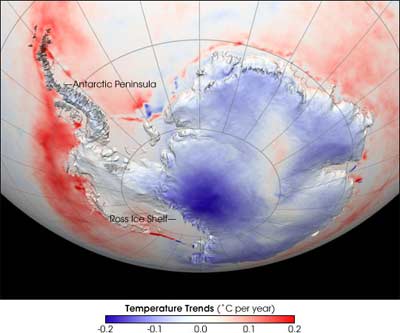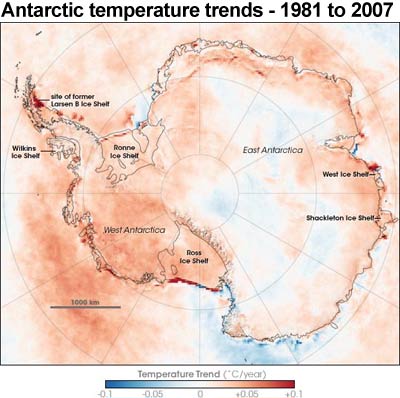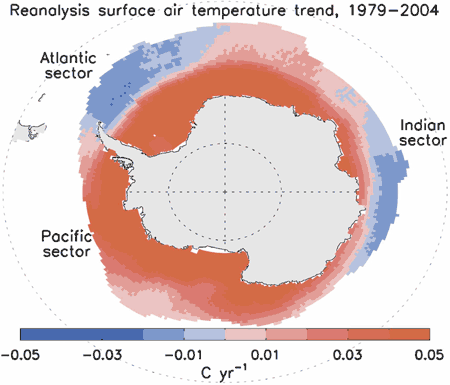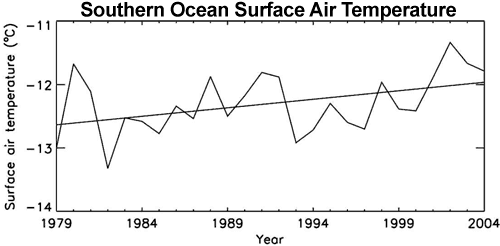Watts Up With That's continued ignorance regarding Antarctic sea ice
Posted on 15 March 2010 by John Cook
Steve Goddard at Watts Up With That has it fixed in his mind that increasing Antarctic sea ice is caused by cooling. When I pointed out that the Southern Ocean where the sea ice forms is actually warming, Steve responded by labelling Skeptical Science a "scummy blog" and a partaker of "intellectual sloppiness". On a more positive side, he also dropped by to clearly articulate why he thinks the Southern Ocean is cooling. So let's examine what the empirical data has to say about temperature trends in the waters around Antarctica.
Steve's basis for Southern Ocean cooling comes from an NSIDC webpage, A brief look at Antarctic sea ice, which makes the following comment:
"A recent report (Turner, et. al., 2009) suggests that the ozone hole has resulted in changes in atmospheric circulation leading to cooling and increasing sea ice extents over much of the Antarctic region."
The NSIDC quote is unclear on whether the changes over "much of the Antarctic region" refer just to sea ice extent or to both sea ice and cooling. The next logical step is to examine the referred paper, Non-annular atmospheric circulation change induced by stratospheric ozone depletion and its role in the recent increase of Antarctic sea ice extent (Turner 2009). This paper uses climate modelling to explore how falling ozone in the stratosphere affects Antarctic climate and in particular, sea ice. The climate models find that falling ozone levels cause cyclonic winds which expose more surface water, leading to increased sea ice production. The only reference to temperature is where the models simulate cooler temperatures in one region of the Southern Ocean, the Ross Sea.
In Steve's defense, you can see how the NSIDC quote could lead one to think Turner 2009 had found cooling has occured "over much of the Antarctic region". However, a little investigation reveals that the paper doesn't offer empirical data on Southern Ocean temperature trends. What it does present is model simulated cooling in one region of the Southern Ocean.
So what do empirical observations tell us? Steve also cites a NASA map of temperature trends from 1981 to 2004. This map shows strong cooling over the East Antarctic continent. However, and more pertinent to sea ice trends, it also shows a strong warming over the Southern Ocean where sea ice forms.

Figure 1: An older NASA image of temperature trends over Antarctica and the Southern Ocean. This image was first published on April 27, 2006 and was based on data from 1981-2004. A more recent version was published on November 21, 2007 (see Figure 2 below). The new version extended the data range through 2007, and was based on a revised analysis that included better inter-calibration among all the satellite records that are part of the time series.
Unfortunately this map is no longer available on the NASA website but before the page went offline, Update: the page wasn't deleted, it was moved to this location (h/t to Robert Simmon). NASA posted a note stating that the temperature map had been updated with new data including better inter-calibration among all the satellite records (see Figure 2 below). The updated data showing more warming over the Antarctic continent. However, as far as sea ice is concerned, both maps shows a warming trend over the Southern Ocean.

Figure 2: Antarctic surface temperatures as observed by satellites between 1981 and 2007 (NASA).
Perhaps Steve was distracted by the continental cooling in Figure 1 and didn't notice the warming over the ocean. In that case, I recommend the following figure from Increasing Antarctic Sea Ice under Warming Atmospheric and Oceanic Conditions (Zhang 2007) as it displays trends only over the ice-covered Southern Ocean - this is the region where Antarctic sea ice forms.

Figure 3: Linear trend (1979–2004) of surface air temperature over the ice-covered areas of the Southern Ocean (Zhang 2007).
We see strong warming over most of the ice-covered Southern Ocean although there is also some cooling. What is the average trend over the whole region? The overall surface temperature trend over the ice-covered regions of the Southern Ocean shows a warming trend:

Figure 4: Annual mean surface air temperature averaged over the ice-covered areas of the Southern Ocean. Straight line is trend line (Zhang 2007).
Oceanographic data also find that the waters in the Southern Ocean are warming. The waters of the Southern Ocean's Antarctic Circumpolar Current have warmed more rapidly than the global ocean as a whole. From 1960 to 2000, water temperature increased by 0.068°C per decade at depths between 300 and 1000 metres. This warming trend has increased to 0.098°C per decade since the 1980s (Boning 2008).
Hopefully, when presented with the full array of empirical data, Steve Goddard will no longer continue the false assertion that Antarctic sea ice is growing because of cooling. Observations clearly state otherwise - the Southern Ocean where sea ice forms is warming. By fixing on a simple yet incorrect interpretation, Steve is depriving himself and his readers of the opportunity to explore the complex and fascinating question of Antarctic sea ice.































 Arguments
Arguments























 0
0  0
0 “The new analysis shows that Antarctic surface temperatures increased by an average of 0.22°F (0.12°C) per decade between 1957 and 2006. That's a rise of more than 1°F (0.5°C) in the last half century. West Antarctica warmed at a higher rate, rising 0.31°F (0.17°C) per decade. The results confirm earlier findings based on limited weather station data and ice cores”.
“The new analysis shows that Antarctic surface temperatures increased by an average of 0.22°F (0.12°C) per decade between 1957 and 2006. That's a rise of more than 1°F (0.5°C) in the last half century. West Antarctica warmed at a higher rate, rising 0.31°F (0.17°C) per decade. The results confirm earlier findings based on limited weather station data and ice cores”.
 As to your view that warming had nothing to do with thick multi-year ice breaking up and being exported out of the Arctic... I suppose we'll just have to agree to live on different planets.
As to your view that warming had nothing to do with thick multi-year ice breaking up and being exported out of the Arctic... I suppose we'll just have to agree to live on different planets.







Comments